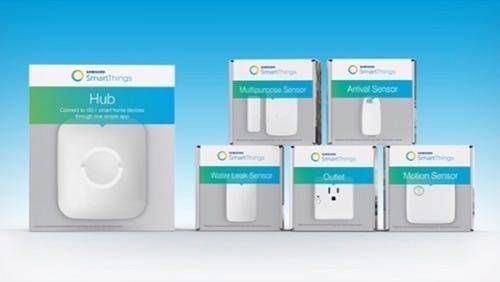Some of the biggest names in the global technology industry have been busy showing off their latest wares at the IFA show in Berlin this week. Among them was Samsung, and central to its moment in the spotlight was an upgraded SmartThings Hub and range of accompanying sensors. It’s the first major product launch from SmartThings since it was acquired by Samsung last August.
The kit is more streamlined and powerful, and the accompanying app is more intelligent; there are also some new developer tools to help reinforce Samsung’s commitment to an open and connected smart home standard. The company says its SmartThings platform is now compatible with nearly 200 other devices (such as the Amazon Echo).
See also: Samsung On Why (And How) Your Future Smart Home Will Probably Be Theirs
Samsung’s latest push into everyone’s smart-home future comes just days after the unveiling of Google’s OnHub router and just days before we’re expecting to see an upgraded Apple TV—a device which many expect to be central to Apple’s future HomeKit smart-home plans. Here’s how the South Korean tech maker is preparing to fend them off.
Deeper Integrations for Developers

The upgrades in the SmartThings kit somehow manage to be substantial, without bringing anything particularly new to the table.
The Hub, for instance, now includes video streaming and 10 hours of battery life (so it can keep working in a power cut). The improved app lets you divide devices up into rooms for separate management and get alerts on the go.
See also: How Your Need For Detergent And Coffee Will Fuel Amazon’s Smart Home
Samsung also took the opportunity at the IFA exhibition to launch a new sleep-tracking device called SleepSense: It sits in on your mattress to keep an eye on the quality of your shut-eye and of course integrates with the SmartThings platform. It certainly looks more comfortable for users than wearing a wristband to bed.
Perhaps more importantly, Samsung expanded its “Works with SmartThings” program to offer “deeper integrations” with the platform to third-party developers—although exactly how that works in practice hasn’t yet been made clear.
That deeper integration sounds like it enables hardware partners to go beyond basic compatibility to operate as seamlessly as SmartThings-branded kit does. (ReadWrite has contacted the company asking for clarity, and will update this post if it responds.)
The move could drastically extend the system, as there are now more than 10,000 developers involved in the SmartThings community, according to Samsung. The list includes big-name partners, such as Honeywell, Yale, D-Link and Bose.
The Connected Landscape Is Still Disconnected
Although Samsung’s lineup of partners seems vast, it bears noting that many hardware makers will happily make products that work with whatever standard other tech giants come up with as well, provided the entry bar is low enough to make it worth their while.
That puts some of the focus on next week’s Apple press event. If the leaks and rumors pan out about the next-generation Apple TV, then Samsung, Google, Apple and Amazon will all have devices on the market designed to sit in your home and control everything from heating and lighting to home security.
See also: Apple’s Fuzzy Vision Of The Smart Home Is Becoming Clearer
From Samsung’s point of view, its advantage over Apple lies in an open smart-home standard that all are welcome to tap into.
“We’re continuing our commitment to deliver the easiest smart home solutions with a truly open ‘Internet of Things’ platform that maximizes collaboration and innovation across the industry,” SmartThings CEO and founder Alex Hawkinson said in a press statement.
Google has similar ambitions with Weave, the cross-platform communications layer the tech giant announced earlier this year. The company also aims to connect everything together using one standard—its own, of course—but the proprietary nature of Weave sets it apart from Samsung’s approach. Still, it makes for major competitor in a line-up of technical juggernauts, with approaches from Apple (HomeKit), Google (Weave and Brillo) and Samsung (SmartThings).
Meanwhile, in the expanding universe of smart homes, hardware and software developers are flying around, racing to support as many platforms as possible. They are very likely wishing the industry would make up its mind and dub one of them the market leader.
To give Samsung its due, at least it’s making the right noises about interoperability—you can use the SmartThings system from Android devices or iPhones. That’s not likely to ever happen with Apple’s HomeKit. But even so, the smart home remains a dizzying maze of products and compatibility issues for both consumers and developers. And it may be several years more before the big companies can lead us (and themselves) out.
Images courtesy of Samsung/SmartThings





















